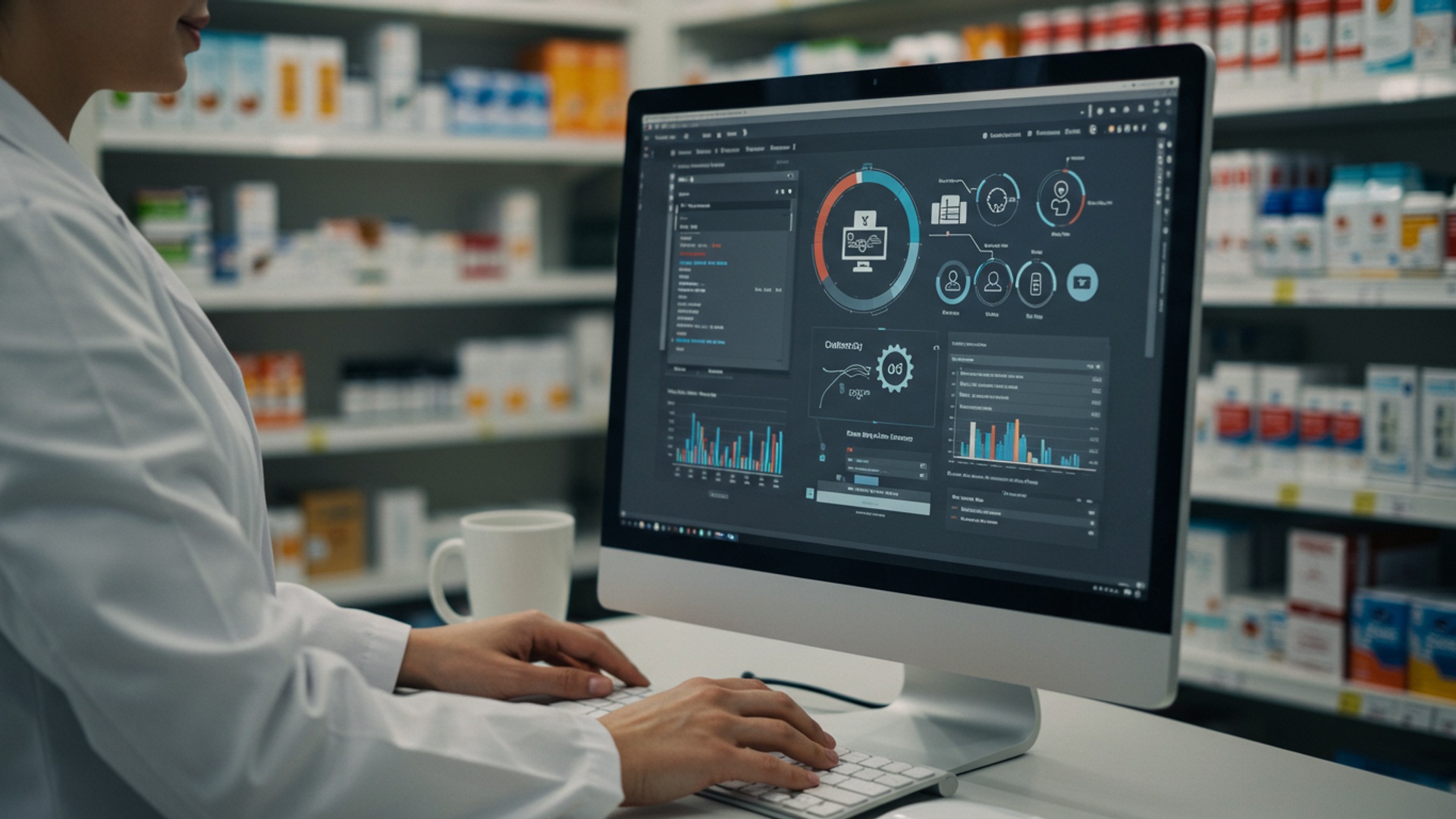5 Essential Pharmacy Management Software Benefits You Need to Know
The contemporary pharmacy operates within a dynamically evolving healthcare ecosystem, grappling with escalating prescription volumes, intricate reimbursement models. an imperative for enhanced patient engagement. Relying on outdated manual workflows or disparate systems no longer suffices. Modern pharmacy management software represents a pivotal technological advancement, moving beyond simple dispensing to offer comprehensive solutions. It actively streamlines complex operations, from real-time inventory optimization and automated claims processing to robust compliance tracking for evolving regulations like DSCSA, directly empowering pharmacists to elevate patient care and navigate the competitive landscape with data-driven efficiency.

1. Enhanced Operational Efficiency and Automation
In today’s fast-paced healthcare environment, operational efficiency is not just a goal; it’s a necessity. Pharmacy management software acts as the central nervous system for a pharmacy, automating a multitude of tasks that traditionally consumed significant staff time and resources. This automation directly translates into faster prescription processing, reduced manual errors. improved workflow, ultimately allowing pharmacists and technicians to focus more on patient care rather than administrative burdens.
Consider the process of prescription entry and verification. Without a robust pharmacy management software, staff would manually input patient details, medication details. physician data. This is not only time-consuming but also highly susceptible to human error. A modern system, But, integrates with electronic prescribing (e-prescribing) systems, allowing for direct, secure transmission of prescriptions from prescribers. This dramatically speeds up the initial entry process and minimizes transcription errors.
For instance, a busy independent pharmacy in a metropolitan area might process hundreds of prescriptions daily. Before implementing a comprehensive pharmacy management software, they might have experienced an average prescription fill time of 15-20 minutes. After adoption, this could be cut down to 5-7 minutes, significantly improving patient satisfaction and allowing the pharmacy to serve more patients without increasing staff headcount. This efficiency gain is critical for maintaining profitability and competitiveness.
- Automated Workflow: Tasks like prescription intake, dispensing, labeling. refill requests are streamlined, often requiring minimal manual intervention.
- Reduced Data Entry Errors: Integration with e-prescribing and patient health records (EHRs) minimizes manual data input, reducing the risk of typos or misinterpretations.
- Faster Dispensing: Automated processes free up staff to handle more complex cases or provide counseling, leading to quicker turnaround times for patients.
// Example of a system alert for an incomplete prescription
alert("Prescription #12345: Missing Prescriber NPI. Action Required.") ;
The impact of this efficiency is profound. According to a study published in the Journal of Pharmacy Technology, pharmacies utilizing advanced management systems reported a significant decrease in prescription processing times and an increase in overall prescription volume handled per pharmacist hour. This allows pharmacies to scale their operations effectively.
2. Improved Patient Safety and Care Quality
At the core of pharmacy practice is patient safety. Medication errors, though often preventable, can have severe consequences. Pharmacy management software provides critical safeguards that significantly enhance patient safety and elevate the quality of care provided. These systems are designed to flag potential issues before medication ever reaches the patient, acting as an indispensable second layer of verification.
One of the most vital features is the comprehensive drug-drug interaction (DDI) and drug-allergy interaction (DAI) screening. When a new prescription is entered, the pharmacy management software automatically cross-references it with the patient’s existing medication profile and known allergies. If a potential interaction or allergy conflict is detected, the system immediately issues an alert, prompting the pharmacist to review the situation and take appropriate action, such as contacting the prescriber for an alternative or providing specific patient counseling.
Consider a scenario where a patient with a known penicillin allergy is prescribed a new antibiotic from the penicillin family. Without a robust system, this critical allergy might be overlooked during a busy shift. A modern pharmacy management software, But, would instantly flag this, preventing a potentially life-threatening allergic reaction. Similarly, if a patient is prescribed two medications that, when taken together, could cause a dangerous interaction (e. g. , increased bleeding risk), the system provides an immediate alert, allowing the pharmacist to intervene.
| Safety Feature | Manual Process | Pharmacy Management Software |
|---|---|---|
| Drug-Drug Interaction Screening | Pharmacist relies on memory or manual lookup, prone to oversight. | Automated, real-time alerts based on comprehensive databases. |
| Allergy Checking | Requires careful review of patient charts, can be missed. | Instantaneous cross-referencing with patient’s allergy profile. |
| Dosing Verification | Pharmacist manually calculates and verifies dose, especially for pediatrics. | System provides suggested doses, flags unusually high/low doses. |
| Patient Counseling Prompts | Pharmacist’s discretion, may vary in consistency. | Automated prompts for specific medication counseling points. |
Moreover, these systems maintain detailed patient profiles, including medical history, chronic conditions. immunization records. This holistic view enables pharmacists to provide more personalized and effective care, identifying opportunities for medication therapy management (MTM) and adherence programs. The result is not just error prevention but also proactive health management, fostering stronger patient-pharmacist relationships and better health outcomes.
3. Optimized Inventory Management and Cost Control
Effective inventory management is crucial for the financial health of any pharmacy. Overstocking leads to capital tied up in slow-moving or expired products, while understocking can result in lost sales and patient dissatisfaction. Pharmacy management software offers sophisticated tools to optimize inventory levels, reduce waste. significantly improve cost control, directly impacting the pharmacy’s bottom line.
These systems track every medication from the moment it enters the pharmacy until it’s dispensed, providing real-time visibility into stock levels. This eliminates the need for manual stock counts, which are labor-intensive and often inaccurate. More importantly, the software uses historical sales data and current trends to forecast demand, helping pharmacies make informed purchasing decisions.
For example, a pharmacy preparing for flu season can leverage its pharmacy management software to review last year’s vaccine demand, current public health advisories. local population demographics to order an optimal quantity of flu shots. This prevents both shortages during peak demand and excess inventory that might expire. Similarly, for controlled substances, the software provides an unalterable audit trail, ensuring compliance with strict regulatory requirements and minimizing diversion risks.
- Real-time Stock Tracking: Know exactly what you have on hand, preventing over-ordering or stock-outs.
- Automated Reordering: Set reorder points. the system can automatically generate purchase orders when stock falls below a predefined threshold.
- Expiry Date Management: Alerts for soon-to-expire medications help prioritize dispensing those items, reducing waste and write-offs.
- Demand Forecasting: review sales data to predict future needs, optimizing purchasing and reducing carrying costs.
- Returns Management: Streamlines the process of returning expired or recalled medications to vendors.
According to industry reports, pharmacies that implement advanced inventory modules within their pharmacy management software can reduce their inventory holding costs by 10-15% annually. This is a significant saving that can be reinvested into other areas of the business or passed on to patients through competitive pricing. Moreover, the ability to quickly identify and return recalled medications ensures patient safety and regulatory compliance, avoiding potential fines and reputational damage.
4. Streamlined Billing and Reimbursement Processes
Navigating the complexities of pharmacy billing and insurance reimbursement can be a daunting and time-consuming task. Errors in claims submission can lead to delays, rejections. significant revenue loss. Pharmacy management software is indispensable in streamlining these processes, ensuring accurate and timely claims, maximizing reimbursement. maintaining compliance with payer regulations.
The software automates much of the claims submission process. Once a prescription is filled, the system can automatically generate and transmit electronic claims to various insurance payers, including private insurers, Medicare. Medicaid. It performs real-time eligibility checks, verifying patient coverage and benefits before the prescription is even dispensed. This proactive approach drastically reduces claim rejections due to invalid coverage or missing details.
Consider a common scenario: a patient’s insurance plan changes, or a new prior authorization is required for a specific medication. Without an integrated pharmacy management software, a manual check might miss this, leading to a rejected claim days or weeks later. A modern system, But, would flag this at the point of dispensing, allowing the pharmacy to address the issue immediately, whether by contacting the patient or the prescriber, or processing the claim with the updated insights. This proactive resolution minimizes delays in payment and improves cash flow.
// Example of a common error code from an insurance rejection
// This would be displayed by the pharmacy management software
errorMessage = "Claim Rejected: Payer Code 07 - Prior Authorization Required." ;
actionNeeded = "Contact Prescriber for PA or Patient for alternative payment." ;
Beyond initial submission, these systems also facilitate efficient reconciliation of payments, tracking what has been paid, what is pending. what has been rejected. This detailed oversight helps pharmacies quickly identify underpayments or discrepancies, allowing for timely appeals and resubmissions. Moreover, the software keeps up-to-date with constantly changing payer rules and formularies, ensuring that submitted claims are compliant and minimizing audit risks. This level of automation and precision is critical for maintaining a healthy revenue cycle in a highly regulated industry.
- Automated Claim Submission: Electronically send claims to multiple payers, reducing manual effort and errors.
- Real-time Eligibility Checks: Verify patient coverage instantly, preventing rejections.
- Prior Authorization Tracking: Manage and track prior authorizations, minimizing claim denials.
- Reconciliation Tools: Easily match payments to claims, identify discrepancies. manage outstanding balances.
- Compliance Assurance: Stay updated with payer rules and regulations, reducing audit risks.
5. Data-Driven Decision Making and Business Growth
In the digital age, data is power. Pharmacy management software doesn’t just manage daily operations; it also collects vast amounts of valuable data that, when properly analyzed, can provide profound insights into a pharmacy’s performance, patient behavior. market trends. This capability for data-driven decision making is a cornerstone for strategic planning and sustained business growth.
These systems generate comprehensive reports on virtually every aspect of the pharmacy’s operations, from sales volume and prescription fill rates to inventory turnover and payer reimbursement trends. Pharmacists and pharmacy owners can use these reports to identify peak business hours, popular medications. areas where efficiency can be further improved. For instance, analyzing sales data might reveal an unmet need for a specific over-the-counter product or a niche compounding service within the local community, prompting the pharmacy to expand its offerings.
Consider a pharmacy owner looking to optimize staffing. By reviewing prescription volume data generated by their pharmacy management software over several months, they might discover that Tuesdays and Fridays from 3 PM to 6 PM consistently experience the highest prescription fills. This insight allows them to strategically schedule more staff during those hours, improving service speed and patient satisfaction, rather than guessing or relying on anecdotal evidence.
- Performance Analytics: Generate reports on sales, prescription volume, dispensing errors. more to gauge operational health.
- Patient Adherence Tracking: Identify patients who may be non-adherent to their medication regimens, enabling targeted outreach and support programs.
- Financial Reporting: Gain a clear understanding of revenue, costs. profitability, aiding budgeting and financial planning.
- Marketing Insights: interpret popular products and services to tailor marketing efforts and expand relevant offerings.
- Staffing Optimization: Use workload data to make informed decisions about staff scheduling and resource allocation.
Beyond internal operations, the aggregated data can also provide insights into broader market trends, competitive positioning. opportunities for new clinical services. For example, by analyzing patient demographics and prescription patterns, a pharmacy might identify a growing need for diabetes management education or immunizations, allowing them to proactively develop and offer these valuable patient services. This strategic application of data transforms a pharmacy from a reactive dispenser of medications into a proactive healthcare hub, driving innovation and ensuring long-term success. The investment in robust pharmacy management software is an investment in the future growth and resilience of the business.
Conclusion
Embracing pharmacy management software isn’t merely an upgrade; it’s a strategic imperative that transforms your operations from the ground up. These five benefits, from streamlined inventory to enhanced patient safety, are game-changers. I’ve personally seen how an integrated system can free up pharmacists, allowing them to truly engage with patients, shifting focus from tedious manual tasks to impactful counseling. Consider how real-time prescription tracking, a modern staple, drastically reduces dispensing errors and improves patient trust. To truly leverage these advantages, my personal tip is to not just look at features. envision the impact on your team’s morale and your patients’ experience. Start by identifying your pharmacy’s biggest bottlenecks and seek software that specifically addresses them. With today’s rising demand for personalized care and efficient service, robust management software isn’t just about keeping pace – it’s about leading the way. Invest in a solution that empowers your staff, secures your inventory. ultimately, elevates the health and satisfaction of your community.
More Articles
Top 6 Pharmacy POS System Benefits for Streamlining Your Operations
Top 8 Benefits of Modern Pharmacy POS Software Solutions
5 Essential Features Your Pharmacy Management Software Must Have
How to Select the Perfect POS Software for Your Retail Store
Mastering POS Software How to Optimize Business Operations for Efficiency
FAQs
Why should my pharmacy even bother with new management software?
New software significantly boosts your pharmacy’s efficiency by automating tasks like prescription filling, inventory tracking. billing. This frees up your staff to focus more on patient care and reduces manual errors, making your operations smoother overall.
How does this software make things safer for patients?
Patient safety is a huge win. The software includes built-in checks for drug interactions, allergies. correct dosages, often flagging potential issues before dispensing. This drastically reduces the risk of medication errors and ensures patients receive the right treatment safely.
My biggest headache is keeping track of all our medicines. Can this software help with inventory?
Absolutely! It offers robust inventory management features. You can monitor stock levels in real-time, get alerts for low stock or expiring medications. even automate reordering based on demand. This minimizes waste, prevents stockouts. ensures you always have essential drugs on hand.
Will it really make our billing and insurance claims easier?
Yes, it streamlines the entire billing process. The software helps with accurate claim submissions, tracks payments, manages patient accounts. often integrates directly with insurance providers. This reduces rejections, speeds up reimbursements. significantly improves your pharmacy’s financial flow.
Beyond just day-to-day stuff, can this software actually help my business grow?
Definitely. Modern pharmacy management software provides valuable data analytics and reporting tools. You can track sales trends, identify popular products, interpret peak hours. assess service performance. These insights empower you to make smarter business decisions, optimize services. drive growth.
What kind of time savings can we realistically expect by using this type of software?
You can expect substantial time savings across the board. Tasks that used to take minutes or even hours, like processing new prescriptions, checking inventory, or generating compliance reports, can now be done in seconds or with minimal clicks. This drastically improves overall workflow and allows your team to be more productive.
Does better software mean a better experience for our customers?
Absolutely! With improved efficiency, faster prescription processing. fewer errors, your staff can dedicate more quality time to patient consultations and provide quicker, more accurate service. This leads to happier, more satisfied customers and builds stronger patient loyalty.



